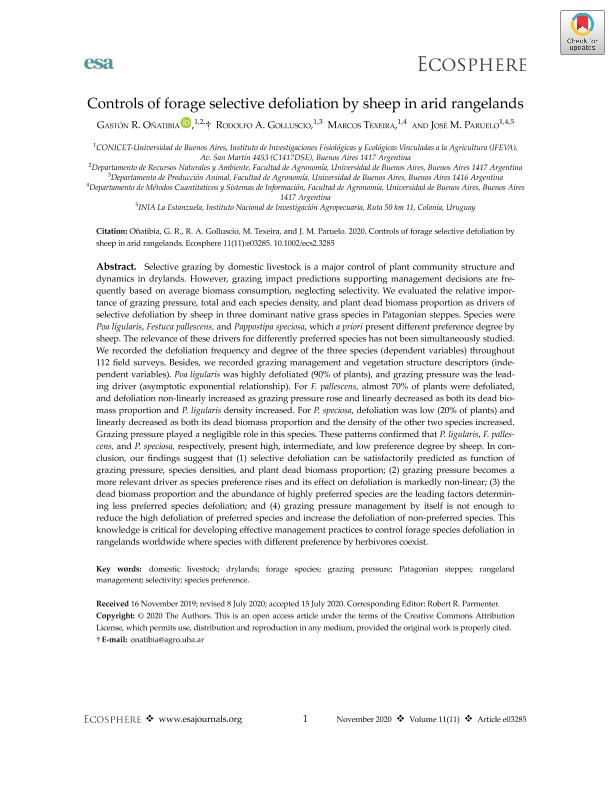Mostrar el registro sencillo del ítem
dc.contributor.author
Oñatibia, Gastón Rafael

dc.contributor.author
Golluscio, Rodolfo

dc.contributor.author
Texeira González, Marcos Alexis

dc.contributor.author
Paruelo, José

dc.date.available
2022-09-15T02:52:52Z
dc.date.issued
2020-11
dc.identifier.citation
Oñatibia, Gastón Rafael; Golluscio, Rodolfo; Texeira González, Marcos Alexis; Paruelo, José; Controls of forage selective defoliation by sheep in arid rangelands; Wiley Blackwell Publishing, Inc; Ecosphere; 11; 11; 11-2020; 1-14
dc.identifier.issn
2150-8925
dc.identifier.uri
http://hdl.handle.net/11336/168801
dc.description.abstract
Selective grazing by domestic livestock is a major control of plant community structure and dynamics in drylands. However, grazing impact predictions supporting management decisions are frequently based on average biomass consumption, neglecting selectivity. We evaluated the relative importance of grazing pressure, total and each species density, and plant dead biomass proportion as drivers of selective defoliation by sheep in three dominant native grass species in Patagonian steppes. Species were Poa ligularis, Festuca pallescens, and Pappostipa speciosa, which a priori present different preference degree by sheep. The relevance of these drivers for differently preferred species has not been simultaneously studied. We recorded the defoliation frequency and degree of the three species (dependent variables) throughout 112 field surveys. Besides, we recorded grazing management and vegetation structure descriptors (independent variables). Poa ligularis was highly defoliated (90% of plants), and grazing pressure was the leading driver (asymptotic exponential relationship). For F. pallescens, almost 70% of plants were defoliated, and defoliation non-linearly increased as grazing pressure rose and linearly decreased as both its dead biomass proportion and P. ligularis density increased. For P. speciosa, defoliation was low (20% of plants) and linearly decreased as both its dead biomass proportion and the density of the other two species increased. Grazing pressure played a negligible role in this species. These patterns confirmed that P. ligularis, F. pallescens, and P. speciosa, respectively, present high, intermediate, and low preference degree by sheep. In conclusion, our findings suggest that (1) selective defoliation can be satisfactorily predicted as function of grazing pressure, species densities, and plant dead biomass proportion; (2) grazing pressure becomes a more relevant driver as species preference rises and its effect on defoliation is markedly non-linear; (3) the dead biomass proportion and the abundance of highly preferred species are the leading factors determining less preferred species defoliation; and (4) grazing pressure management by itself is not enough to reduce the high defoliation of preferred species and increase the defoliation of non-preferred species. This knowledge is critical for developing effective management practices to control forage species defoliation in rangelands worldwide where species with different preference by herbivores coexist.
dc.format
application/pdf
dc.language.iso
eng
dc.publisher
Wiley Blackwell Publishing, Inc

dc.rights
info:eu-repo/semantics/openAccess
dc.rights.uri
https://creativecommons.org/licenses/by/2.5/ar/
dc.subject
DOMESTIC LIVESTOCK
dc.subject
DRYLANDS
dc.subject
FORAGE SPECIES
dc.subject
GRAZING PRESSURE
dc.subject
PATAGONIAN STEPPES
dc.subject
RANGELAND MANAGEMENT
dc.subject
SELECTIVITY
dc.subject
SPECIES PREFERENCE
dc.subject.classification
Ecología

dc.subject.classification
Ciencias Biológicas

dc.subject.classification
CIENCIAS NATURALES Y EXACTAS

dc.title
Controls of forage selective defoliation by sheep in arid rangelands
dc.type
info:eu-repo/semantics/article
dc.type
info:ar-repo/semantics/artículo
dc.type
info:eu-repo/semantics/publishedVersion
dc.date.updated
2021-09-07T15:17:56Z
dc.identifier.eissn
2150-8925
dc.journal.volume
11
dc.journal.number
11
dc.journal.pagination
1-14
dc.journal.pais
Estados Unidos

dc.journal.ciudad
Washington
dc.description.fil
Fil: Oñatibia, Gastón Rafael. Consejo Nacional de Investigaciones Científicas y Técnicas. Oficina de Coordinación Administrativa Parque Centenario. Instituto de Investigaciones Fisiológicas y Ecológicas Vinculadas a la Agricultura. Universidad de Buenos Aires. Facultad de Agronomía. Instituto de Investigaciones Fisiológicas y Ecológicas Vinculadas a la Agricultura; Argentina
dc.description.fil
Fil: Golluscio, Rodolfo. Universidad de Buenos Aires. Facultad de Agronomía. Departamento de Producción Animal. Cátedra de Forrajicultura; Argentina. Consejo Nacional de Investigaciones Científicas y Técnicas. Oficina de Coordinación Administrativa Parque Centenario. Instituto de Investigaciones Fisiológicas y Ecológicas Vinculadas a la Agricultura. Universidad de Buenos Aires. Facultad de Agronomía. Instituto de Investigaciones Fisiológicas y Ecológicas Vinculadas a la Agricultura; Argentina
dc.description.fil
Fil: Texeira González, Marcos Alexis. Universidad de Buenos Aires. Facultad de Agronomía. Departamento de Métodos Cuantitativos y Sistemas de Información; Argentina. Consejo Nacional de Investigaciones Científicas y Técnicas. Oficina de Coordinación Administrativa Parque Centenario. Instituto de Investigaciones Fisiológicas y Ecológicas Vinculadas a la Agricultura. Universidad de Buenos Aires. Facultad de Agronomía. Instituto de Investigaciones Fisiológicas y Ecológicas Vinculadas a la Agricultura; Argentina
dc.description.fil
Fil: Paruelo, José. Instituto Nacional de Investigacion Agropecuaria; Uruguay. Consejo Nacional de Investigaciones Científicas y Técnicas. Oficina de Coordinación Administrativa Parque Centenario. Instituto de Investigaciones Fisiológicas y Ecológicas Vinculadas a la Agricultura. Universidad de Buenos Aires. Facultad de Agronomía. Instituto de Investigaciones Fisiológicas y Ecológicas Vinculadas a la Agricultura; Argentina
dc.journal.title
Ecosphere
dc.relation.alternativeid
info:eu-repo/semantics/altIdentifier/url/https://onlinelibrary.wiley.com/doi/10.1002/ecs2.3285
dc.relation.alternativeid
info:eu-repo/semantics/altIdentifier/doi/http://dx.doi.org/10.1002/ecs2.3285
Archivos asociados
